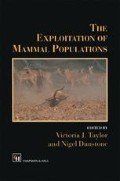Synopsis
The sustainability of uses of wild mammals should be judged by assessing the impacts of the uses on both the ecosystem and the human system. This chapter proposes a framework for assessment, categorizing uses in terms of their combined impacts on the ecosystem and human system as good, bad, neutral or unknown.
Application of this framework for assessment is illustrated with five cases: vizcacha hunting in Argentina; kangaroo harvesting in Australia; furbearer trapping in Canada; squirrel monkey viewing in Costa Rica; and Communal Areas Management Programme for Indigenous Resources (CAMPFIRE) in Zimbabwe.
Three of these uses are considered to be good (probably sustainable: to be encouraged), one bad (probably unsustainable: to be reformed) and one neutral (low priority for attention). Mutually supportive changes in values, incentives and laws are required to turn bad uses into good uses.
In all five cases, the limited and often fragmentary information available — from both formal and informal sources — is nonetheless sufficient to assess impacts of the uses on the ecosystem. Information about impacts of the uses on the human system needs improvement, although interim conclusions can still be drawn.
Access this chapter
Tax calculation will be finalised at checkout
Purchases are for personal use only
Preview
Unable to display preview. Download preview PDF.
References
Prescott-Allen, R. and Prescott-Allen C. (eds) (1996) Assessing the Sustainability of Uses of Wild Species. Case Studies and Initial Assessment Procedure, IUCN, Gland, Switzerland. Chapters include: Child, B. (1996) CAMPHRE in Zimbabwe.
Grigg, G. (1996) Harvesting kangaroos in Australia.
Jackson, J.E. (1996) Vizcacha hunting. Part of: Jackson, J.E., Bucher, E.H., and Chani, J.M. Capture of blue-fronted amazons and hunting of vizcachas and tegu lizards in Argentina.
Slough, B.G. and Jessup, R.H. (1996) Furbearer trapping in the Yukon, Canada.
Wong, G. and Carrillo, E. (1996) Squirrel monkey viewing and tourism in Costa Rica.
Editor information
Editors and Affiliations
Rights and permissions
Copyright information
© 1996 Chapman & Hall
About this chapter
Cite this chapter
Prescott-Allen, R., Prescott-Allen, C. (1996). Assessing the impacts of uses of mammals: the good, the bad and the neutral. In: Taylor, V.J., Dunstone, N. (eds) The Exploitation of Mammal Populations. Springer, Dordrecht. https://doi.org/10.1007/978-94-009-1525-1_4
Download citation
DOI: https://doi.org/10.1007/978-94-009-1525-1_4
Publisher Name: Springer, Dordrecht
Print ISBN: 978-94-010-7182-6
Online ISBN: 978-94-009-1525-1
eBook Packages: Springer Book Archive

